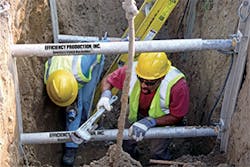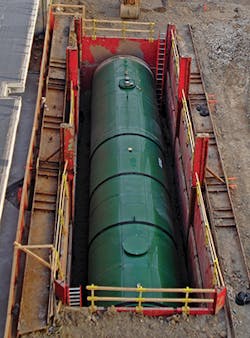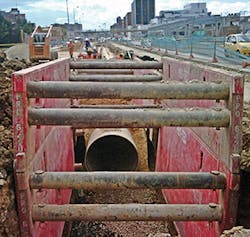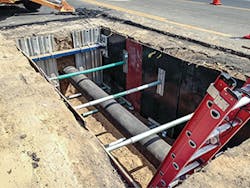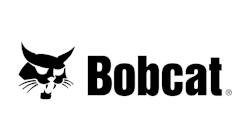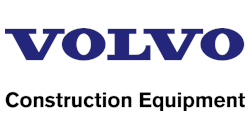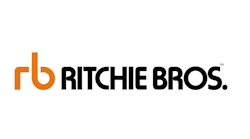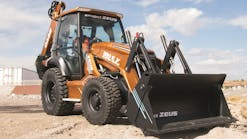Trenching and shoring equipment has evolved over time, with more options available now than ever before.
“If it’s properly used, the equipment saves time as a production tool in that there are fewer machine cycles, less wear and tear on the machine, a lot less time in terms of having to move the soil, and restoration costs go way down,” says Wendell Wood, trainer and senior project manager for National Trench Safety.
To get the best performance out of equipment and to do so safely, contractors should refer to the manufacturer’s tabulated data located on trench boxes and other shoring products, Wood points out.
While shoring equipment has been “remarkably static for a number of years,” the last few years would indicate that some people are tackling special issues, Wood says.
“Putting together a four-sided trench shield—and especially when stacked for depths to 24 feet—has been a problem for many,” he says. “The slide rail, which arrived in 1980 to the US from Germany/England, was not readily accepted until the 1990s and has become a staple for equipment suppliers and manufacturers in the last 20 years.
“It can be found in every region of the US, especially for pump stations, tank removals and installations, and occasionally for large area shoring, removing internal bracing, and utilizing a Mega Brace to provide inside clearance.”
Wood says there are numerous advantages over trench shields in such applications, “especially control of ground subsidence, use of smaller excavators in cramped quarters, and the ability to provide compaction from the ground up in appropriate increments per engineering specifications.”
Contractors in some areas, due to ground conditions, still prefer to use trench shields, says Wood.
“However, the ability to get compaction from the ground up is limited,” he says. “Large equipment and/or cranes are needed for installation and removal. This particular use of shields is prominent in Virginia, the Carolinas, and Georgia in lieu of slide rails and the maintenance issues and rental costs of that equipment at that time.”
Wood points out that in the late 1970s through the 1980s, most contractors used sloping for protective systems.
“You didn’t have to rent anything; you just created the slope out there in the field,” he says. “But in doing that, you are constantly juggling priority of safety and productivity. The operator would have to charge more or less to keep it as vertical as possible, but then the contractor would admonish him about not wanting anyone to get hurt so they’d gradually layer back.
“Because deaths were more common with the use of sloping, OSHA introduced soils analysis and sloping charts as early as 1983. In those sloping charts, it became economically infeasible to slope and be legal. OSHA did not raise the question of whether they are safe slopes, but what is a legal slope or a compliant slope. In unstable soil, they said at 1.5H:1V and contractors defaulted to C soils and in defaulting to C soils, it just doesn’t make sense to slope anymore.”
Sloping not only takes a tremendous amount of time but also increases wear and tear on the machines as well, says Wood.
“A lot of dirt is being moved. There are a lot of fuel costs. Restoration costs go sky high,” he says.
Thus, there was a big uptick in the use of trench boxes in the 1990s and also in aluminum products for small contractors with small machines, says Wood.
“Properly use a box and you’re keeping things in a vertical wall, except unstable soil will sometimes continue to slough off and come inside the box around the edges, so then a contractor will shore off the front and back of the box,” says Wood.
“Working it down to grade, the high-rigid design—which has been there since the 1970s—allows contractors to have a box that works with them rather than fighting them. We started with welded boxes and then they would fight you, but now the rigid works best.”
Lightweight aluminum shoring quickly caught on and expanded, says Wood.
“Extruded aluminum products introduced in the early 1990s also became a dominant offering and, in some areas of the country, more readily accepted and used over the vertical shoring equipment common on the West Coast where there are limited groundwater issues since the early 1960s,” adds Wood.
“They can be used in many different fashions in many different applications. They are lightweight and provide protection for people. There is still an aspect in which a contractor—in an effort to be productive—mishandles the box in terms of lifting it and setting it in place, so in times past we had issues of people being hurt with material coming underneath a protective system.”
Now, equipment moving sideways in a trench “is a little bit more under control,” says Wood. “Where contractors have difficulties is in putting them together and then sometimes there seems to be an issue that’s developing with surcharge loads out in the field.”
Wood points out as another option the snap-in-place system such as offered by Trench Shoring Services.
“In the late 1980s, Dennis Spencer developed a lightweight aluminum shield product with limited but sufficient depth ratings that can have snap-in-place end panels for the repair and maintenance pits common in utility and gas operations in cities and municipalities,” he says.
The average contractor specializing in repair and maintenance work and residential plumbing work “would gravitate toward aluminum products that could be handled by the lightweight machines used to reach the relatively shallow water and sewer lines typical in lateral work,” adds Wood.
Wood points out that the Canadian firm GroundWorks Safety Systems offers a snap-in-place solution. The company designed its high-tensile steel Gravity Lock Trench Box System that can be installed in less than 15 minutes with one machine, an operator, and one worker.
Its 4 Sided Universal Connector System makes it so boxes can be stacked or made four-sided within minutes. Two Gravity Lock Trench Boxes can be assembled and stacked in under 40 minutes and a four-sided box can be done in less than one hour. A stacked four-sided box can be done in under three hours.
The panels can be turned 90 degrees and used with adapters on the universal connector system. The 4-foot panels that go on top of the box are connected with heavy-duty adapters.
The last few years also have led to the use of a Mega Brace for large area shoring, notes Wood
“Once the domain of steel sheeting, walers, and uprights, a Mega Brace is now well-entrenched, with some suggesting it will replace slide rail use and become a staple for rental of the major shoring equipment distributors,” says Wood.
A slide rail tank installation by Trinity Shoring
The introduction of a Dynamic Cone Penetrometer provides a level of safety unknown in recent years past, says Wendell.
“Today, real-time loads of a pit, shaft, or similar excavations can be known through these penetrometers,” he adds. “The pen actually sends out emails to critical players such as the site foremen, engineers, and equipment suppliers when loads reach previously determined levels especially when surcharge loads of equipment either germane to the operation or a possible part of other job site activity so the pit or shaft will not become overloaded and fail, causing a catastrophic calamity.”
Production is one of the many benefits of trench shoring and shielding equipment, says Tommy Marciniak, corporate marketing manager and dealer sales for Pro-Tec Equipment, adding that crews are able to install more pipe per day when using the trench shoring and shielding systems.
Worker safety is another benefit. The company’s equipment is designed and engineered to withstand the pressures of being used during underground construction projects, says Marciniak.
“The use of trench shoring and shielding equipment has saved thousands of lives by either protecting workers who are inside the system during a trench collapse with trench shields or by preventing trench collapses with trench shoring.”
All shoring equipment is primarily a safety device to protect workers in an excavation from potential cave-ins, notes James McRay, director of marketing and media, Efficiency Production.
“Both trench shields and hydraulic shores are considered an appropriate protective system by OSHA’s standards for trenching and excavation,” he says.
McRay points out that Efficiency Production was founded by T.A. Forsberg in 1971, an underground utility contractor who saw the benefits of trench shields as a production tool, not just a safety tool.
“Forsberg knew he would get more pipe production in a day and in turn make more money simply by removing less dirt when installing pipe,” he says. “The easiest way to do that was to use a steel trench box, which allowed the excavation to be only as wide as the width of the trench shield.
“It was then no longer necessary to remove excess dirt just to safely slope the banks of the excavation. The trench box allowed efficient production.”
One company that relies on Efficiency Production products is Zito Construction in Grand Blanc, MI. The infrastructure contractor company specializes in excavating, road building, water mains, and sewer mains on Michigan private developments and public works projects.
The company’s president, John Zito, says the products have an easy learning curve for the crews, which tackle small and large projects.
While his company derives efficiency and production benefits from Efficiency Production trenching and shoring products, Zito notes that safety is the biggest concern in using them.
A Trinity Shoring trench shield
“You look at the ground conditions and depth, consider the diameter and length of pipe, and choose the shoring system accordingly,” notes Zito.
Todd Hayes, vice president, United Rentals Trench Safety, echoes the notion that safety and productivity are the two main benefits of using shoring and shields.
“And compliance, of course—it’s an OSHA requirement to use slope, bench, shield, or shore protection at any depth where a potential cave-in is anticipated by the competent person and it’s mandatory for excavations five feet or deeper,” he adds.
With regards to productivity, because shields and shores limit the excavation footprint, they reduce the amount of dirt that needs to be removed and in some cases materials that need to be transported offsite, notes Hayes.
“A smaller footprint also means less backfilling and compaction costs at the end,” says Hayes. “All of this saves time and money. It also reduces site activity around the excavation, which enhances safety. Worker protection is required by law and it’s important that workers understand shoring and shielding systems to ensure their safe use.”
Having the appropriate equipment for a small job or large job involves parameters, notes Wood.
“A small project utilizes three trench boxes or less,” he says. “Even smaller would be the ones using aluminum products. On job sites such as pump stations and large excavations, you’ll find big braces and slide rail shoring.”
Industry experts point out that trench shoring and shielding equipment portability depends on its size, weight, and the project for which it is being employed.
“If the application, site, and soil conditions warrant hydraulic shores or light aluminum shields, these can be transported in a pickup truck or with a small trailer,” notes Hayes. “Both of these solutions work well with smaller earth-moving machines that have limited digging depths and lifting capacities for the installation of utility lines, for example.”
Shoring equipment is quite portable, Wood says. Many regions now have several shoring distributors who can make deliveries and provide boom trucks, he adds.
“Some of the products are designed to be hauled around in a pick up truck,” he adds. “There are some that can be transported on flatbed trucks.”
As long as a contractor follows the manufacturer’s tabulated data and uses the appropriate cables, the equipment can be easy to install and remove, notes Wood.
Procedures such as attaching a box at all four corners that a manufacturer has provided should not be short-circuited, he adds.
“If you are using long spreaders, let the box or the side of the box that has the long spreaders lower that down where the guys can be on the ground and not have to use ladders or anything like that to make adjustments,” says Wood.
“Many people who use boxes never take time to read the tabulated data,” says Wood. “It’s a situation where people are assuming they’ve been in the field and know how to use the products and they actually could stand to take refresher courses and work more diligently.”
Shoring equipment provided by United Rentals
Hydraulic trench shoring is a versatile and portable system that protects against cave-ins, Hayes points out.
“These shores can help contractors minimize their trench or excavation footprint which reduces the time and cost of restoration,” he adds. “Hydraulic systems are especially useful when working around utilities that cross, whereas a shield may not work in tight workspaces.”
Shield solutions offer a couple of lighter options that can be transported efficiently, says Hayes, adding that one is an aluminum shield configured with two aluminum panels.
Typically 8 feet high and ranging from 6 to 16 feet in length, they’re assembled with spreaders, he adds.
Another aluminum option is a modular system comprised of 2-foot-tall panels from 3 to 12 feet long assembled to corner posts with pins and keepers. The systems can be configured as two-sided, three-sided or four-sided shield protection, says Hayes.
“Steel trench shields are designed for bigger excavation projects and must be handled with heavy machinery such as track-excavators that have the lift capacity to handle the shield,” says McRay.
“However, many shoring manufacturers—including Efficiency Production—make lightweight aluminum shields and even more versatile hydraulic vertical shores,” he adds.
“Aluminum shields are designed to be handled by a rubber-tire backhoe and can easily be transported on a trailer and in some cases in the back of a pick up truck. Hydraulic shores are designed to be installed by a single person for spot or emergency use.”
Marciniak notes that the company’s smallest and lightest equipment “can easily be shipped in the back of a pick up truck, while our larger trench shields, slide rail systems, and bracing systems can be shipped via flatbed trailers.”
All of Pro-Tec Equipment’s trench shoring and shielding equipment is designed and manufactured with lifting points to allow safe and easy installation on the job site, says Marciniak. “These same installation points are used to remove the products from the excavations as well.”
Hydraulic shores consist of a pair of 8-inch aluminum rails connected cross-trench with hydraulic cylinders. Once placed in a trench, the shore’s hydraulic cylinders are activated by a hand pump.
The shores push against the sides of the trench, sending pressure arcs into the surrounding soil, says McRay, adding that the arching effect prevents the trench walls from caving in.
“Ease of use starts with understanding the applications and limitations of each system,” points out Hayes. “This requires a competent person familiar with the manufacturers’ tabulated data as well as site conditions such as soils analysis, utility placements, adjacent structures, and groundwater conditions.”
Additionally, the correct rigging, taglines, and earthmovers must be onsite to handle the equipment and the installation depths, he adds.
“Manufacturers’ tabulated data also provides instructions for system assembly, installation, and removal,” says Hayes. “For example, hydraulic shores are always installed above grade. The contractor must use the proper hook and release tool as the bucket pump extends the shore to apply between 750 and 1,500 psi of pressure against the trench wall.
“Our United Rentals Trench Safety specialists are often called on for job site consultation, tabulated data review, and safety demonstrations to make the process as easy as possible for the contractor.”
Best practices in planning a shoring project from start to finish would begin with obtaining the site plans along with any and all geotechnical reports for the site, says Marciniak.
“The site plans would need to include any crossing utilities along with adjacent structures to the excavation,” he says. “With those plans and an understanding of how big the excavation needs to be, a local trench shoring and shielding dealer would be able to recommend the best equipment to suit the job needs.”
Every good excavation project takes shoring equipment into consideration while planning and designing the project, notes McRay.
“Even before work begins, a good excavation contractor will know how deep they will be digging, what the soil conditions are for the dirt they will be digging in, and the capacity of their heavy equipment to handle the shoring,” he says. “All of these factors will allow the contractor to bring the right shoring equipment to the job site before the work starts.”
The best practices in planning a shoring project from start to finish begin at the bid point, when contractors take into consideration depths, soil conditions, lifts, water conditions, and underground utility issues, says Wood, adding that the length is going to be determined by the length of the pipe.
“Almost everything a contractor needs can be rented,” says Wood. “For the most part, contractors do not need to buy a lot of boxes.”
Hayes says the priority in planning a shoring project is contractors understanding the importance of the many options available—not only for equipment but also for trench safety resources that support the full project life cycle.
“We see contractors increasingly opting to partner with trench safety specialists that can provide resources in the planning stage as well as from project start to finish,” he says.
The required training of a competent person is more than just checking a box, Hayes adds.
“When choosing a training provider, contractors should compare the content of training programs, particularly lessons presented beyond the basic OSHA standards and mandated instruction,” he adds. “A more robust training curriculum is a valuable resource and a way to stay up to date on the latest developments in shielding, shoring, and engineered solutions.”
Beyond training, contractors bidding larger, more complex projects—or challenging configurations of any size—benefit from expert advice very early in the process, notes Hayes.
United Rentals often provides three-dimensional shoring and shielding designs during a contractor’s submittal stage designed to elevate best practices in the project planning stage with the concepts clearly presented in detail, says Hayes.
“When shoring and shielding plans are designed by professional engineers, this helps to protect the project’s profit margin because the safest and most efficient decisions have been made up front,” he adds.